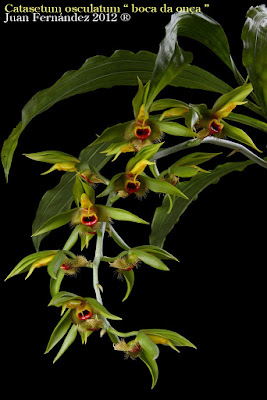Catasetum osculatum is found in Brazil, states of Mato Grosso (Upper Taquari River), Mato Grosso do Sul, and Rondônia (Cacoal). It grows mainly in gallery forest, usually on living palm trees or other, dead trees at elevations of 200 to 500 meters.
Catasetum osculatum, also called as Osculum Catasetum (referring to the orifice of the lip cavity, with raised, rounded, reddish margins), is a species of the genus Catasetum. This species was described by Lacerda & Vitorino Paiva Castro in 1995.
IDENTIFY CATASETUM OSCULATUM ORCHID PLANT
Catasetum osculatum is found in Brazil, states of Mato Grosso (Upper Taquari River), Mato Grosso do Sul, and Rondônia (Cacoal). It grows mainly in gallery forest, usually on living palm trees or other, dead trees at elevations of 200 to 500 meters.
It is a large sized, hot growing, epiphytic species with clustered, fusiform, to 26 cm long and 4 cm wide pseudobulbs enveloped basally by several deciduous, leaf sheaths carrying up to 11, arched, oblanceolate, plicate, to 58 cm long and 11 cm wide leaves.
This orchid blooms in the fall on a basal, arching to pendant, 46 cm long, racemose, to 20 flowered inflorescence arising on a newly mature pseudobulb. The male flowers are 52 × 75 mm with coloration of pedicels light green (to dark brown in other clones); sepals light green (brown or red-brown in other clones, with or without darker spots); petals lighter green (or yellowish in other clones, sometimes with purplish or dark brown pigmentation); lip light green (from yellowish to green-brown or brown in other clones); column also light green (to green-brown in other clones). The female flowers are 75 × 52 mm with green color.
This species is often confused with Catasetum saccatum. Inflorescence initially erect, pedicels short, flowers smaller and green or yellow-green or green-brown, lip almost heart-shaped, with an elliptic to almost circular orifice, pollinarium short.
CATASETUM OSCULATUM ORCHID PLANT CARE AND CULTURE
Cultural information should only be used as a guide, and should be to be adapted to suit you. Your physical location; where you grow your plants, how much time you have to devote to their care, and many other factors, will need to be taken into account. Only then can you decide on the cultural methods that best suit you and your plants.
Light:
Catasetum osculatum are sun-loving plant and needs a light level of 30000-60000 lux. 40-60 % shade is recommended, especially if male flowers are desired. This species can be grown under lights if sufficient light intensity can be provided, and the plant certainly can be summered outdoors if their moisture requirements can be met.
Temperature:
The climate in their natural habitat is essentially continental. The dry season is long and the humidity is very low throughout much of the year. Days are hot and dry, while nights are fairly cool. The terrain is typically tropical to subtropical savannah country, with the surface soil shallow and incapable of sustaining large trees. Temperatures range from a maximum 40°C to a minimum 10°C. In cultivation, 18°C is the ideal minimum night temperature.
Humidity:
This species tolerate an environment with 40 - 60 % relative humidity during their growing season, but for optimal development of new growth and flowering, 70 % is recommended.
Substrate, growing media and repotting:
Catasetum osculatum is a large plant with pendent inflorescences and is best grown in a basket with fir bark, osmunda, tree fern fiber, charcoal, and sphagnum, in various proportions or combined with still other ingredients such as sponge rock, perlite, leaf mold, peat, and bark screenings as substrate.
It is recommended to repot every year and never wait more than two years. The optimal time for potting or repotting is when new growth on a plant emerging from dormancy is about 5 cm tall and the nubs have developed into new roots that are reaching for support.
Watering:
In its natural habitat it receives rainfall frequently even while dormant. Basket-grown plant may be watered every sunny day during the growing season, provided conditions are such that they dry off relatively quickly.
Fertilizer:
Fertilize with an appropriate formulation at least every week during the growing season, or fertilize with a weak formula every time the plants are watered. It is important to begin regular applications of high-nitrogen fertilizer (such as 10-5-5) with a full range of trace elements. As the leaves begin to unfurl, and well before flowering, add a high-phosphorus formula to develop big, strong pseudobulbs capable of producing robust inflorescences. Any of the soluble products with a large second-digit number (for example, 3-12-6) constitute a good source of phosphorous.
Rest period:
When the Catasetum osculatum plants are leafless and no new growths are visible, the grower must respect their state of dormancy. Watering frequency should be reduced during dormancy. Fertilization should stop completely during this period. In the springtime, at the beginning of the growth cycle, water should not be made regularly available for the newly developing roots until the new growth is at least 5 cm tall.















COMMENTS